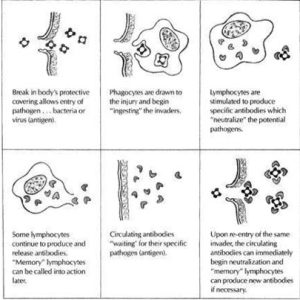The Classic Comprehensive Handbook of Cat Care
PREVENTIVE VACCINATION PROCEDURES
There are several major infectious diseases for which safe and effective vaccines are available: among them rabies, feline panleukopenia (feline enteritis, feline “distemper”), and viral respiratory infections (rhinotracheitis, calicivirus). Each of these diseases can easily cause death in an unprotected cat. We are very fortunate to be able to prevent such serious illnesses with a procedure as technically simple as vaccination. (For more information on vaccines available for cats).
HOW VACCINES WORK
Antigens are molecules with particular areas on their surfaces that are recognized as foreign to the body. Antibodies are protein substances produced in the body that are responsible for recognizing these antigens.
They are produced by cells called lymphocytes that originate in the bone marrow and multiply in the thymus, spleen, and lymph nodes. When lymphocytes recognize that a foreign substance (antigen), such as a virus or bacterium, has entered the body, they begin copious production of antibodies specific for the invader. Lymphocytes capable of antibody production against the invader multiply to produce progeny cells capable of producing the same antibodies. Some of these progeny cells immediately begin producing antibodies, while others become resting cells that serve as the body’s “memory” of the invader. If the same (or a very similar) invader makes an appearance again later, these cells are able to respond quickly to its presence.
Vaccination introduces a modified disease agent into the body.
Common methods of altering an organism’s ability to produce disease are by chemical killing and by “breeding” to an innocuous state. Biotechnology can also produce vaccines that consist of harmless immunity-inducing portions of agents that cause disease when they enter the body intact.
Modified viruses or bacteria are able to induce lymphocytes to produce antibodies capable of protecting the body against disease without actually producing illness. Frequently the body produces a higher (usually more protective) level of antibodies that are more specific to a disease agent on the second exposure to a vaccine, but different vaccines vary in their ability to produce a protective antibody level on first exposure. The duration of the body’s immunological memory for different viruses and bacteria also varies. These are two reasons why the number of original vaccinations necessary for protection and the frequency of booster vaccinations vary with each disease.
YOUNG ANIMALS ARE SPECIAL CASES
Additional factors influence the vaccinations of a young animal. Cats and dogs receive a small amount of antibodies across the placenta (the organ that communicates between mother and fetus before birth). They receive a much greater amount in the colostrum (first milk) and milk when they are nursing. Kittens are capable of absorbing some antibodies through their gut for several days following birth, but the first twenty-four hours are most important. The amount of antibody received against each particular disease is dependent on the level of circulating antibody in the mother. The antibody received from the mother serves primarily to protect the kitten against disease for the first few weeks of life. Whether or not a nursing kitten receives a protective level of antibody depends on how recently the mother was exposed to the disease in question or how recently she was vaccinated. The antibody a cat receives can be a disadvantage as well as being useful since it can interfere with vaccination by tying up the vaccination-introduced antigen before it can stimulate the kitten’s immune system. The protection kittens receive early in life against feline distemper is an example.
Some kittens lose their protective immunity against panleukopenia (feline “distemper”) acquired in nursing as early as six weeks of age, others as late as four months after birth. Therefore, the ideal vaccination schedule is individualized for each cat, and the last vaccination is given after twelve to sixteen weeks of age. There are tests for determining the level of antibody against panleukopenia in each cat, but, in general, they are too expensive and time-consuming for routine use.
The techniques of vaccination are relatively simple. Knowledge of the proper handling of vaccines and of the physiology of the immune response is what makes it important to have your cat vaccinated by a veterinarian who is interested in each animal as an individual. Vaccination by a good veterinarian also insures that your cat gets a physical examination when he or she is young, and then also later, which may reveal important changes you have missed. Regular visits during the initial kitten vaccination series also provide a time to discuss any behavior or training problems you may have with your pet and allows a young animal to become well adjusted to visits to an animal hospital. If a veterinarian vaccinates your cat without taking a thorough history or performing a thorough physical examination and discussing your pet with you, something is amiss!
